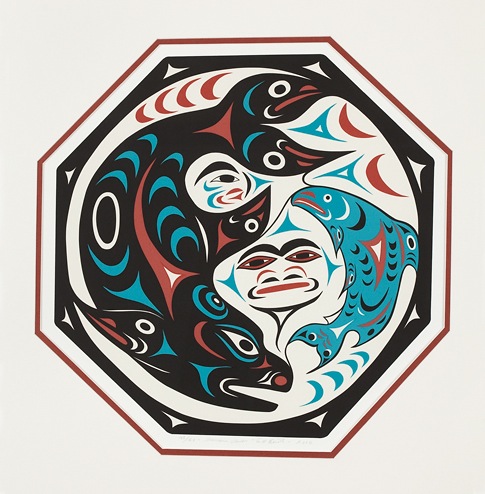Serigraph: Ink on Paper
Shamans Vision
Artist/Curatorial Statement
This print is titled Shamans Vision or Shna’em as we say in our language. The original artwork was actually a hexagon drum made of deerskin on which I painted this design. Such deerskin drums are part of our culture. I painted the drum using acrylic paint, a very contemporary medium, but used traditional colours except for the blue, which I introduced in this Salish design. This colour is now part of our culture and known as the Salish blue. Prior to painting this drum with the Salish blue, I was using a colour close to it, a ‘bluey green’ colour which was proper oxide green. The drum was created in 1994 and the print was created in 2000.
This design includes an orca, a salmon and the face of a Shaman or a Shna’em. In our culture, we had people who could see the future, people who could heal the mind, people who could help in different ways. Sometimes our spirit or soul, whatever you want to call it, is not completely in line with ourselves. The Shamans were able to line people up, so that they were a whole person again, in line with their spiritual and physical sides. We had ways of looking into and seeing things and one of them was by using water. Our Shamans and our Medicine people could stir the water, look into the water and see images and things. That is what this design is about. The larger face of the Shaman is looking into the water seeking the vision that will help a person, the smaller face in the design, align their spirit with their own self again. The Shamans helped people by being able to see what other people couldn’t, using water the same way as a crystal ball.
The orca and the salmon symbolize the struggle and the dance of life. The salmon is part of our survival as it is part of the survival of the orca and other creatures in the ocean. They are in constant play with each other; it’s just what they do.
I wanted this image to be pure Salish design and that is what it is. It makes a statement on our Medicine people, their duties and the things they can do.
Charles Elliott
Exhibition(s): Record, (Re)create: Contemporary Coast Salish Art from the Salish Weave Collection
Legacy: National Gallery of Canada

